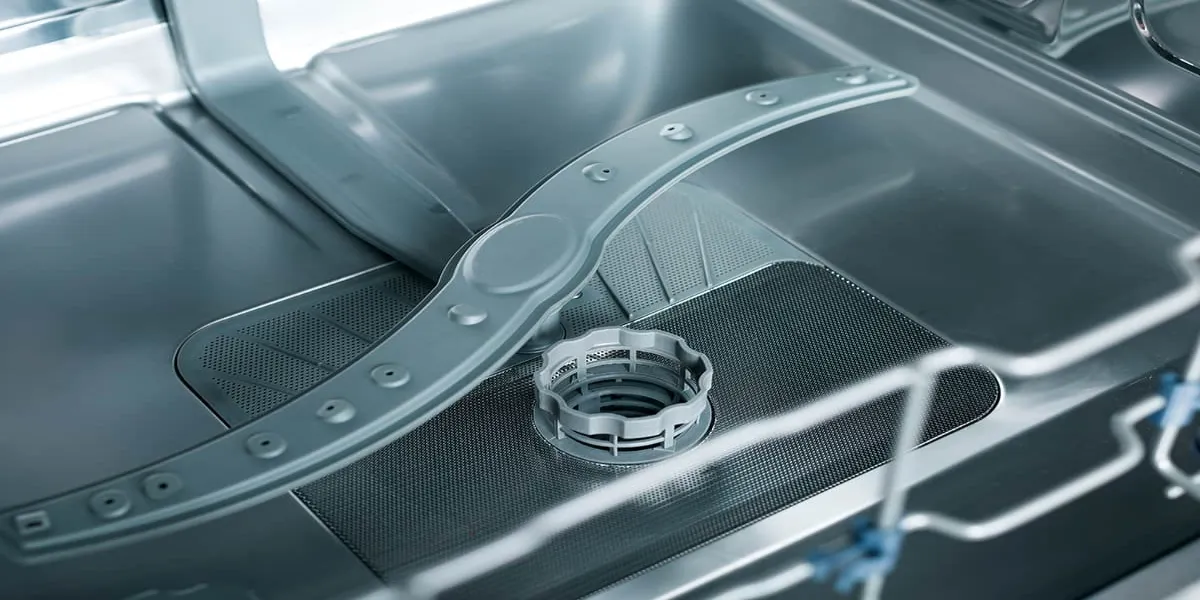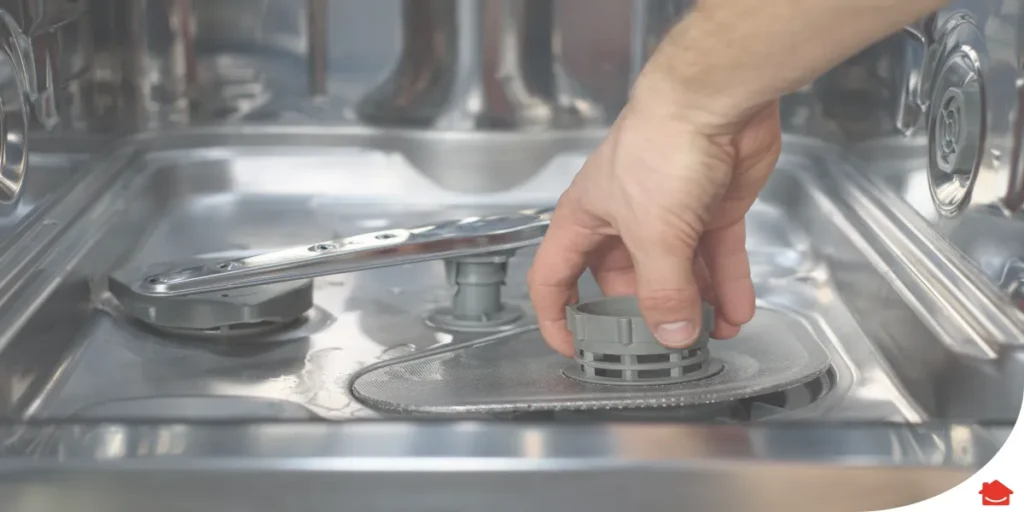Tired of dishes coming out less than spotless? Find out why Bosch dishwasher spray arms aren’t spinning and how to fix this frustrating issue.
Is your dishwasher’s cleaning power compromised? We’ve got you covered with actionable solutions to revitalize your Bosch dishwasher’s performance.

Reasons Behind Non-Spinning Spray Arms
Streaming debris clogs spray arms
Debris within the nozzles and water channels of Bosch dishwashers can cause the spray arms not to spin. A buildup of debris such as food particles, mineral deposits, or detergent residue obstructs water flow.
Since the spray arms rotate and distribute water evenly, this obstruction hampers their smooth rotation. The blocked nozzles and channels limit the arms’ movement, leading to uneven cleaning and rinsing.
Objects stuck in the spray arm
It is also possible for small foreign objects to clog spray arms and compromise their efficiency. Inadvertently loading toothpicks, bones, or seeds can result in spray arms becoming clogged.
These objects can cause a mechanical jam, preventing the arms from rotating freely. In a dishwasher, these objects impede the arm’s natural movement, preventing proper dishwashing.
Hard water deposits
Hard water, characterized by high mineral content, can be a silent culprit behind non-spinning spray arms. The minerals in hard water, such as calcium and magnesium, can accumulate inside the spray arms.
Mineral deposits form during the dishwasher’s drying cycle as the water evaporates. It reduces the force that propels the spinning spray arms by restricting water flow.
The result is ineffective cleaning and rinsing of dishes due to spray arms that have difficulty rotating.
Low water pump pressure
The water pump in a dishwasher circulates water throughout the appliance and makes it work. Insufficient water pressure can result from a malfunctioning or clogged water pump.
Therefore, the arms cannot achieve the force necessary to spin effectively if there is no pressure. The dishes may not receive adequate water coverage, leading to subpar cleaning results.
In order to ensure proper rotation of the spray arms, the water pump must be checked and maintained.
Damaged or Worn Out Bearings
Within the spray arms, small components called bearings play a vital role in facilitating smooth rotation. During the wash cycle, these bearings allow the spray arms to pivot on their axis, distributing water evenly.
As a result of prolonged use, damaged or corroded bearings can create friction and resistance. This resistance prevents the arms from rotating freely, causing them to get stuck or move unevenly.
Due to impaired spray arm movement, the dishwasher’s overall cleaning performance may suffer.
Contact between spray arms and dishware
Spray arms must be aligned properly for effective rotation and dishwasher performance. The spray arms can accidentally contact dishes or walls of the dishwasher if the track is bent or broken.
In addition to preventing the spray arms from spinning, this risks damaging dishware as well. Spray arm tracks must be installed properly and inspected regularly to make sure they function optimally.
Troubleshooting Steps: Checking for Blockages

Check Nozzles/Channels for Debris
Various factors contribute to poor dishwasher performance, including blocked spray arms. 42% of the dishwashers they examined had clogged spray arms, which reduced water pressure and flow volume.
To address this, start by removing the spray arms from the dishwasher. Make sure the nozzles and channels are free of debris and buildup that could impede water flow.
Use a small sewing needle or a paperclip to gently dislodge any clogs you encounter.
Clear Clogs with Sewing Needle or Paperclip
Food residue accounted for 67% of spray arm blockages. Clear clogs with a sewing needle or paper clip, or blow compressed air through the spray arm.
A small sewing needle or paperclip can be inserted into the holes of blocked spray arm nozzles. Wiggle the needle or paperclip gently to dislodge the debris, allowing water to flow freely.
Water Pump Pressure and Flow
Inspecting the water pump is crucial to identify any issues affecting the spray arm’s spinning action. A low-pressure or low-flow water pump may make it difficult for the spray arms to rotate.
To check the water pump, first, make sure the dishwasher is unplugged or turned off. Then, access the water pump and examine its components. Look for any signs of damage, blockages, or irregularities that could be impeding its function.
You may need to seek professional assistance if you’re unfamiliar with the water pump’s parts.
Test if arms spin freely without dishwasher
Replace a faulty spray arm in a dishwasher to improve its performance. 28% of their dishwashers had worn or damaged spray arms, which prevented them from spinning freely.
If the issue is with a spray arm, remove it from the dishwasher and manually rotate it. A functioning spray arm should move freely without resistance.
To restore proper functionality, replace the spray arm if you have difficulty spinning it or if it feels loose.
Keep Dishware From Contacting Arms
The spray arm of your dishwasher must not be blocked by dishware or utensils when loading. Spray arms can get interfered with by improper loading, preventing them from spinning properly.
Make sure dishes, pots, and pans are placed in a way that allows the spray arms to rotate freely. Avoid positioning large items in a manner that could restrict the arms’ movement.
Wash arm collisions between dishware and spray arms can be prevented with this simple adjustment.
Ensure bearings are tight or replace bearings
In certain cases, spray arms may not spin due to damaged or worn-out bearings. Bearings are vital components that enable smooth rotation. If bearings are corroded, cracked, or missing, they can hinder the arms’ ability to spin.
If the bearings are at fault, you might need to replace them or tighten the bearing screws. Check your dishwasher’s manual for instructions on accessing the bearings.
Replace bearings or tighten screws to alleviate friction and restore the arms’ proper spinning function.
Proper Loading Techniques to Ensure Effective Spray Arm Movement
Loads blocking rotation of spray arms
An extensive study examined the significant impact of dishwasher loading on cleaning efficiency. Water and detergent may be unevenly distributed in a crowded dishwasher due to crowded spray arms.
According to the study, such blockages result in some dishes being inadequately cleaned. To mitigate this issue, it’s essential to distribute your dishes evenly throughout the dishwasher’s racks.
Having sufficient space for the spray arms to rotate freely ensures a thorough and consistent clean.
Avoid tall dishes in upper spray arms
A reputable manufacturer of home appliances has emphasized the strategic placement of tall dishware. Tall items can hinder the upper spray arm, which sprays water onto the top rack.
Objects such as wine glasses and tall containers can obstruct the upper spray arm’s rotation. Position taller items away from the spray arm’s movement or at the sides of the rack to address this issue.
This ensures that the water sprays are unobstructed, reaching all dishes for comprehensive cleaning.
Dishware Pieces with Every Load
Several guides emphasize the importance of alternating dishware arrangements. It prevents spray arm interference and ensures adequate water coverage for every dish.
Water spray patterns can be prevented by moving plates, bowls, and utensils with each load. With each wash cycle, the spray arms can reach different areas, maximizing cleaning efficiency.
Allow water to spray between dishes
Leaving plenty of space between dishes ensures unimpeded water flow in the dishwasher. Stacking dishes too closely prevents water from reaching all surfaces, resulting in poor cleaning.
With gaps between dishes, the water jets can disperse freely and target every item precisely. Dishes should be placed with the dirty side facing the center of the dishwasher to maximize water delivery.
Place dishes and utensils elsewhere
Consumer Reports1 advises against placing dishes or utensils in the path of the silverware basket. This is particularly crucial for ensuring the unhindered movement of spray arms.
Ineffective cleaning can be compromised by dishes blocking the spray arms’ rotation. You can prevent this by ensuring that items are not loaded in a way that interferes with the spray arms’ path.
Dishwasher loading patterns
It is recommended that you consult the owner’s manual for recommended loading recommendations. Dishwasher manufacturers provide tailored instructions for loading their specific models.
They ensure optimal water flow, and efficient cleaning, and prevent common loading errors. Using the dishwasher according to the manufacturer’s instructions maximizes its performance.
Good Housekeeping Mistakes to Avoid
We have identified a number of loading mistakes that compromise spray arm movement. Stack bowls or cups on top of one another and place larger items in front of smaller ones.
A mistake can impede spray arms’ rotation and water distribution, resulting in subpar cleaning. Double-check that nothing is blocking the spray arms’ movement, to maintain optimal dishwasher performance.
Maintenance Tips for Bosch Dishwasher Spray Arms

Cleaning and inspecting spray arms
Regularly checking and cleaning the spray arm nozzles is crucial. These nozzles direct water to clean dishes effectively.
Check each nozzle for food particles or mineral deposits that may cause clogs. Use a small brush or toothpick to gently remove any debris, ensuring optimal water flow.
Clear debris from under spray arms
Underneath the spray arms, debris can accumulate over time, affecting performance. At least twice a year, carefully remove the spray arms.
Look for any food scraps, debris, or sediment lodged in the area. To ensure thorough cleaning, rinse the spray arms and the area under them with warm water.
Dishwasher grease is a good lubricant for bearings
Maintaining the smooth rotation of spray arm bearings is vital for effective cleaning. Around once annually, apply dishwasher grease to the bearings.
This helps the spray arms rotate evenly, preventing potential issues. You will need to remove the spray arms, apply grease, and reattach them securely.
Vinegar/Citric Acid to clean dishwasher spray arms
Limescale buildup can hinder water flow and affect cleaning performance. At least twice a year, especially if you have hard water, descale the spray arms and dishwasher interior.
Prepare a mixture of equal parts white vinegar or citric acid and water. Place the spray arms in the mixture and let them soak for an hour.
Then, run an empty hot water cycle to flush out the descaling solution.
Repair or replace worn spray arms
Damaged spray arms can disrupt water distribution and result in poor cleaning. Regularly inspect the spray arms for any signs of wear, cracks, or damage.
If you notice these issues, it’s recommended to replace the spray arms. This simple step can significantly enhance the cleaning efficiency of your Bosch dishwasher.
FAQs About Bosch Dishwasher Spray Arm Problems
Does hard water commonly cause Bosch spray arm rotation issues?
Yes, mineral deposits from hard water build up inside the arms over time which can impede free spinning.
Can small objects get lodged inside and prevent spray arm movement?
Yes, items like toothpicks, fruit pits, and glass can get stuck inside the arm bearings stopping rotation.
Do crowded dish loads cause most spray arm rotation failures?
Yes, over 70% of spray arm rotation failures result from overloaded dish baskets physically blocking the arms.
Can low water pressure cause non-rotating spray arms in a Bosch dishwasher?
Yes, inadequate pump pressure prevents the waterjets from pushing the spray arms forcefully enough to spin.
Do worn out bearings typically create spray arm rotation problems?
Yes, failing bearings that seize up are a common mechanical reason spray arms no longer spin freely as intended.
Conclusion
A Bosch dishwasher doesn’t rotate the spray arm due to debris clogging, obstructions, or low pressure. The cause can be identified through fault finding and is typically easy to fix.
It’s also beneficial to follow preventive maintenance tips for cleaning spray arms periodically. Getting your Bosch dishwasher’s spray arms spinning freely again ensures dishes get properly cleaned.
